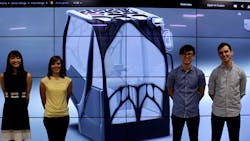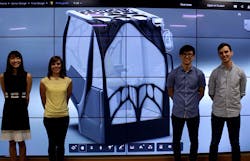This file type includes high-resolution graphics and schematics when applicable.
While some students focus on their studies, others find time to burn the candle at both ends and participate in contests, too. This year, a team from the University of Illinois Department of Mechanical Science and Engineering entered a competition that not only put $2,000 in each of their pockets, but the students will travel to Oak Ridge National Laboratory (ORNL) to observe the printing of the design. Then the ORNL will use the 2017 International Manufacturing Technology Show (IMTS) as a public testing ground to print their design live at the show along with other components, such as the boom.
After a semester of designing, the team integrated controls of an excavator, along with other features, directly into a 1/16th scale model to win a nationwide competition. The team of students won because of their ability to leverage new technology to develop a creative design that offers safety, ergonomics, manufacturability, and aesthetics. The judges included representatives from Bobcat, Caterpillar, CNH, Donaldson, and Eaton.
The team of students includes Naomi Audet (noise and vibration reduction, and FEA), Kevin Kim (safety and material testing), Luke Meyer (structure and material testing), Andrew Peterman (loading conditions and FEA), and Sharon Tsubaki-Liu (topology optimization, 3D modeling). Sameh Tawfick is the faculty advisor and Blake Johnson is senior design course instructor.
Machine Design had a chance to speak with Luke Meyer about what it’s like to participate in this project and find time to study.
What motivated you and the team to participate in the contest?
I think most of us had a strong desire to participate in a senior design project where we could be creative. The additive excavator-cab design competition had very few limitations on the cab design and encouraged students to showcase their skills and ideas. We could create something unique and aesthetically pleasing, yet functional.
What is it about the future of construction or 3D printing that excites or inspires you?
It is incredible to think that an entire structure such as an excavator cab can be produced in a single build. Reinforced plastics could prove to be a viable replacement for some metals. A singular structure can place fillets in every corner to reduce stress concentrations, showing how an additive-manufactured cab of plastic can be stronger than a traditional one.
What makes your team’s design different from any other design or today’s current cabs?
When comparing to the industry-standard cab, our design is one that has never before been possible. Current cabs will typically have strong material, such as steel, that is welded together in many different steps. This exhibits high structural integrity, but limiting creativity to a four-post structure. Our team utilized topographical optimization (TO) to create a very organic and treelike cab structure.
Incorporating many curving features is not possible by means of traditional manufacturing. We were also able to maximize visibility with gridded roofing and reduce both noise and vibration with structural air gaps.
What was the biggest challenge in designing the cab?
The biggest challenge in the design process was satisfying the safety constraints. Our original design process was wholly creative, using other industries for inspiration—impact-resistant, helmet-like designs, and circular helicopter-like designs—but we found that multiple iterations were necessary. Placing the designs in finite-element-analysis (FEA) simulations pinpointed areas of high stress or abnormal deflections, where we would need to make small adjustments.
We realized that we should use a more mathematical approach, which is where TO was explored. A combination of TO and creative design led to the final design, giving the team confidence that the material was distributed in the best manner to provide a safe environment for the operator.
How is designing something for 3D printing different, more challenging, or easier than a typical design?
3D printing introduces unique challenges to the design process. Angles less than 60 deg. with respect to a horizontal print direction and overhanging features require support structures. Minimal support structure is important when designing for 3D printing. Material properties will be anisotropic since the print is developed layer by layer; therefore, introducing weak spots where the material fuses from one layer was another important thing to consider during the design process.
A requirement of the competition was to satisfy Tip-Over Protective Structure standards. As a result, the TO process was ideal, because it could incorporate the structural differences in lateral and longitudinal loading. In general, it is challenging to design for functional 3D printing, but the benefits outweigh the additional time spent in modeling.
Does your school encourage entering contests?
The University of Illinois is very encouraging when it comes to contests, both through the support of clubs and hosting internal competitions. Every year, teams such as the Illinois Solar Decathlon, Illinois Formula SAE, Formula Electric, and Baja SAE are formed and funded with the intent of competing at a national level. There are also many opportunities like the MechSE Innovation Trophy Competition, which is a contest that encourages students to be creative and entrepreneurial. External competitions are sometimes shared through the weekly newsletter from the Mechanical Engineering department, and other times recommended as a Senior Design Project. The latter is actually how we found the Additive Manufactured Excavator Cab Design Competition, and the department supported us without hesitation.
Was it difficult to balance school and find time to participate in this competition?
Being part of our Senior Design Project, we knew a competition could be more difficult due to its one sole deadline. Other projects have sponsors that oversee the design teams with specific goals to fulfill periodically throughout a semester, whereas we had a set of deliverables to be completed by early May. Our team was very intent on creating something we could be proud of, which entailed many hours each week between meetings, design, and testing. I would say that any engineering curriculum entails a substantial amount of time management between classes, and that really prepared us to work well in this competition.
MD: How important are competitions like this to engineering students? Would you encourage students to compete or spend the time studying?
I would encourage engineering students to compete in at least one competition, either outside of their normal curriculum or through a project-oriented class such as in our case. I feel that they allow students to gain traction with hands-on engineering applications and see the impact that they can have on the real world.
Academic coursework can do an amazing job of teaching us, as future engineers, how to think and effectively solve problems. However, students can gain a lot of valuable experience actually solving these problems firsthand through contests. Obviously, it is not wise to let any one thing consume all of your time, so it is important to keep a balance of schoolwork and extracurricular activities—like competitions!
What do competitions do for students?
Competitions can give students the freedom to apply their engineering knowledge in a genuinely creative way—sometimes for the first time since starting as an undergraduate. With any engineering problem, the first—and at times most crucial—aspect is to gain background information, where we utilize our professors and professional acquaintances to gain insight. Through this network, students can see how similar problems have been solved in the past and how we can modify techniques or use them as inspiration for the given situation.
Knowledge gained in a plethora of classes is called upon simultaneously in the design process, whether it is creating something with structural integrity, tough dimensional or material restrictions, building for a certain environment/climate, or any number of other constraints. Competitions like this are also unique in that they allow students to see how other teams from across the nation tackled the problem, and compare the similarities and differences from their own.
From my personal experience, I have found that they can even show students areas that they may not initially explore. Without this competition, I may not have found the impact that additive manufacturing can have on the construction industry and how much I am interested in helping.
What other contest winners do you think found innovative ways to solve problems? What contests should students and/or engineers know about? Please email me ([email protected]) or post your response in the comment section below.
The excavator is a collaboration between the Association of Equipment Manufacturers (AEM), National Fluid Power Association (NFPA), Center for Compact and Efficient Fluid Power (CCEFP), Oak Ridge National Laboratory (ORNL) and the National Science Foundation (NSF). This project was supported by DOE’s Office of Energy Efficiency and Renewable Energy – Advanced Manufacturing Office.




